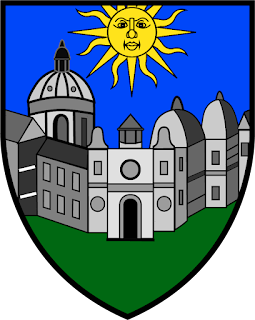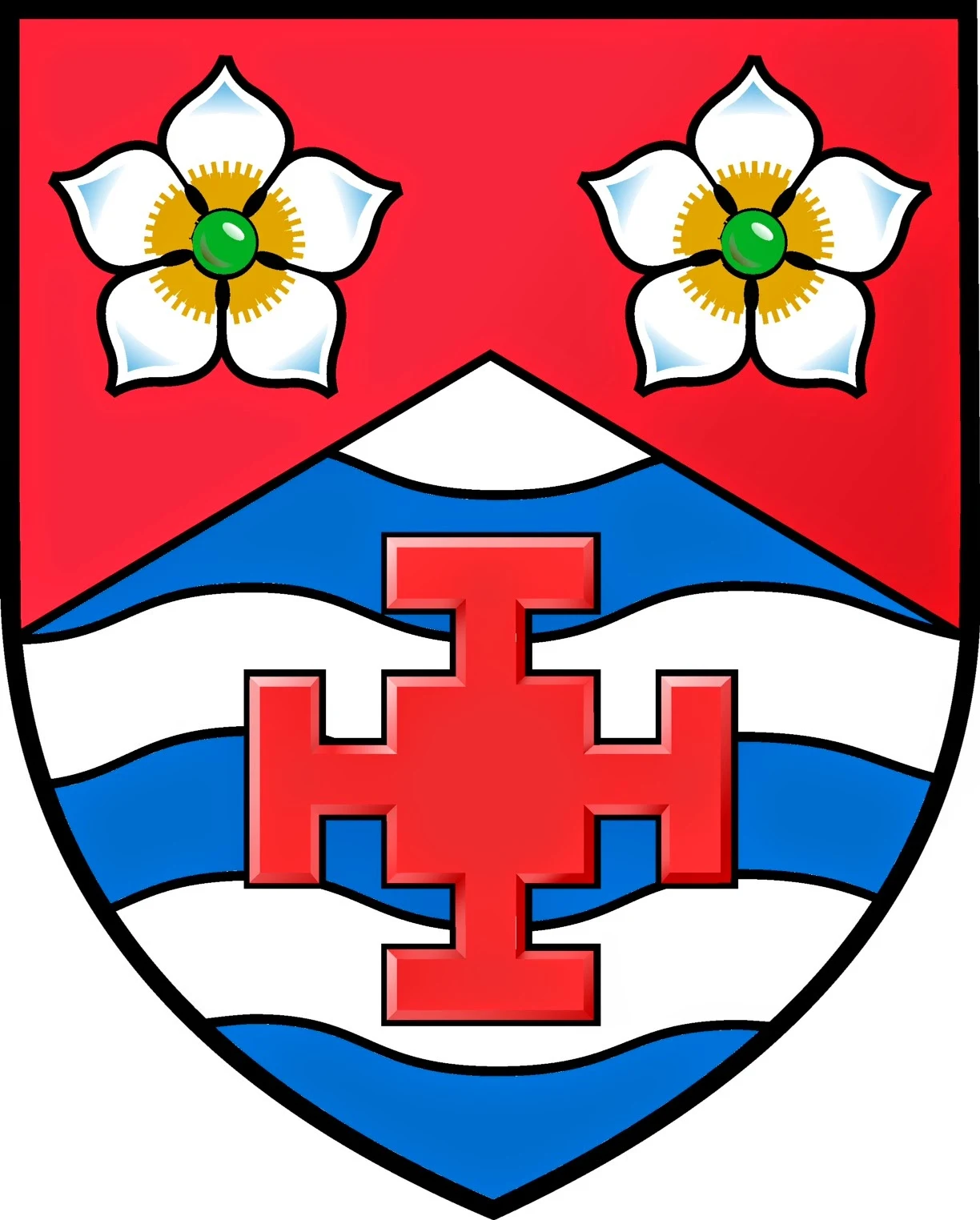 |
| The coat of arms of the College of William & Mary Rendered by Chad Krouse, 2025 |
One can hardly discuss scholastic heraldry in the US or even the Commonwealth of Virginia without mentioning the arms of the state's oldest institution of higher learning, the College of William & Mary located in Williamsburg. Granted by the College of Arms in London on May 14, 1694, the arms are blazoned: "Vert, a colledge or edifice mason'd argent; in chief a sun rising or the hemisphere proper, as in the margent hereof is more plainly depicted." (Donald M. Sweig, "Vert a Colledge...:A Study of the Coat-of-Arms and Seals of the College of William and Mary in Virginia," The Virginia Magazine of History and Biography, Vol. 84, No. 2, April 1976, page 143). Jack E. Morpurgo gives the blazon as, "Vert, a colledge or edifice mason'd argent in chief a sun rising or" (Their Majesties' Royall Colledge,Washington, DC: Hennage Creative Printers, 1976, 36).
 |
| The College's arms as rendered on their letters patent |
I am somewhat conflicted about these arms. I'm reminded of L.G. Pine's statement regarding good heraldry and the legitimacy of arms--just because they're legally granted does not mean that they're good arms. With the opening of a new colony, new resources, new everything, I suppose the heralds were not inclined to change convention with regards to new charges. Is it a coincidence that the "colledge" looks a bit like Oxford?
fThe brilliance of the sun seems overshadowed by a depressed star. In some way, I suppose the heralds saw the new world with the cracked lens of the old; heraldry was not going to take off in a new direction and create any new trends. Not then, at least.
It is worth noting that the college changed their seal, dropping these arms, in favor of a republican-looking temple which has been recorded on an honorary degree granted March 6, 1790 (Sweig, 146). Moreover, the seal of Virginia also changed in 1776. Sweig recounts this poignant quotation from Lyon G. Tyler (1894):
"The Revolution was, in Virginia, a revolution not only in government, but in church, education, and sentiment generally. Monarchy in every guise became odious. The Roman Republic presented at that time the highest exemplars of virtues and heroism known to history...Heraldry, the history of pedigrees, fell into utter disrespect" (Sweig, 146).
Interestingly enough, the College's coat of arms have somewhat disappeared over the years as the royal cypher has seemingly become the brand of choice.
Conveyed by letters patent dated 17 October 1976, the town surrounding campus would receive its own devisal of arms from London. The coat of arms for the City of Williamsburg incorporates two elements of unification with those of the College, mainly the golden sun in splendor and the color green. The seven billets spread across the field represent the orderly layout and design for the colonial town.
Another grant of arms from London around the same time as the College, Francis Nicholson (1655-1728) who would later serve as Governor of the Province of Virginia among other offices. Nicholson was also a founder of the college. His arms are blazoned: "Azure, on a cross argent between four suns or, a cathedral church gules" (Morpurgo, 36). Below is a sketch of Nicholson's arms as found in The New England Historical and Genealogical Register, 1885, Vol XXXIX, page 73.
This should help give a sense of heraldry at the close of the Seventeenth Century. All in all, I love history, especially Virginia history. I am proud that this old Virginia institution is and has been such a force in the Commonwealth. Whether or not I like their arms, of course, is irrelevant.
It is worth noting that the college changed their seal, dropping these arms, in favor of a republican-looking temple which has been recorded on an honorary degree granted March 6, 1790 (Sweig, 146). Moreover, the seal of Virginia also changed in 1776. Sweig recounts this poignant quotation from Lyon G. Tyler (1894):
"The Revolution was, in Virginia, a revolution not only in government, but in church, education, and sentiment generally. Monarchy in every guise became odious. The Roman Republic presented at that time the highest exemplars of virtues and heroism known to history...Heraldry, the history of pedigrees, fell into utter disrespect" (Sweig, 146).
Interestingly enough, the College's coat of arms have somewhat disappeared over the years as the royal cypher has seemingly become the brand of choice.
 |
| The coat of arms of the City of Williamsburg, Virginia Rendered by Chad Krouse, 2025 |
Another grant of arms from London around the same time as the College, Francis Nicholson (1655-1728) who would later serve as Governor of the Province of Virginia among other offices. Nicholson was also a founder of the college. His arms are blazoned: "Azure, on a cross argent between four suns or, a cathedral church gules" (Morpurgo, 36). Below is a sketch of Nicholson's arms as found in The New England Historical and Genealogical Register, 1885, Vol XXXIX, page 73.
The Arms of Francis Nicholson (1655-1728)
Granted March 9, 1694
This should help give a sense of heraldry at the close of the Seventeenth Century. All in all, I love history, especially Virginia history. I am proud that this old Virginia institution is and has been such a force in the Commonwealth. Whether or not I like their arms, of course, is irrelevant.










.JPG)








